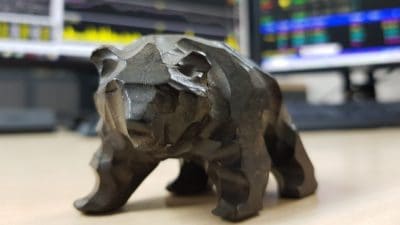With the shares down, is it finally time to add Lloyds Banking Group plc (LSE: LLOY) to my portfolio?
At first glance, the valuation seems attractive. At today’s share price near 57p Lloyds trades close to its tangible net asset value of 55p per share, the forward price-to-earnings ratio sits around nine for 2017, and the forward dividend yield is almost 6%.
Beware banks with low-looking valuations
However, the usual methods that investors use to time investments — such as seeking a low valuation — don’t work well with cyclical firms such as banks. Lloyds seems cheap but I’m wary because cyclicals can be dangerous for investors after a period of high profits and when the valuation looks low.
Back in June, I penned an article about Lloyds when the shares were 71p pointing out the varied fortunes of investors taking the plunge with the firm at various points between June 2012 and June 2016.
Depending on the time of purchase, those holding shares through to June 2016 would have seen their total returns varying between gains of 187% and losses of 21%. That’s a big variance and underlines the risks involved in the timing of an investment in cyclical enterprises such as Lloyds.
In the three-and-a-half months since my article the outcome for those still holding Lloyds has deteriorated. Here’s an updated table showing how your investment would have worked out if you had bought the firm’s shares at six monthly intervals from 1 June 2012 and held your purchase until 13 September 2016. Trading costs are ignored for this example:
|
Dividends |
Buy price |
Price on 13/9/16 |
Share price gain/loss |
Dividends |
Total return in pence per share |
Total return in percentage |
|
1/6/12 |
26p |
56p |
30p |
3.5p |
33.5p |
129% |
|
1/12/12 |
46p |
56p |
10p |
3.5p |
13.5p |
29% |
|
1/6/13 |
62p |
56p |
(6p) |
3.5p |
(2.5p) |
(4%) |
|
1/12/13 |
79p |
56p |
(23p) |
3.5p |
(19.5p) |
(25%) |
|
1/6/14 |
77p |
56p |
(21p) |
3.5p |
(17.5p) |
(23%) |
|
1/12/14 |
80p |
56p |
(24p) |
3.5p |
(20.5p) |
(26%) |
|
1/6/15 |
89p |
56p |
(33p) |
2.75p |
(30.25p) |
(34%) |
|
1/12/15 |
74p |
56p |
(18p) |
2p |
(16p) |
(22%) |
|
1/6/16 |
71p |
56p |
(15p) |
0 |
(15p) |
(21%) |
By holding on since early June returns have fallen and seven out of a possible nine six-monthly entry points show a loss. The range of returns has shifted down too, from 187% to minus 21%, down to 129% to minus 34%.
Headwinds
The way Lloyds’ share price plunged in the wake of the Brexit vote underlines how sensitive cyclical firms can be to macroeconomic events. When earnings have recovered from a cyclical low point — as now with Lloyds — there’s much more downside risk for earnings and for the share price than there is potential for upside gain, in my view.
In the middle of a macrocycle, when earnings are high for banks such as Lloyds, the stock market tends to mark down valuations of the cyclical firms, trying to anticipate the next cyclical plunge in profits. Such valuation-compression can drag on investor total returns at a time when growth looks hard to achieve, which can manifest as a double whammy to thwart investors.
I think the table demonstrates that time is not your friend if you hold cyclicals such as Lloyds, but it’s possible to make quick gains by trading the shares if you can catch the upleg of the cycle. The stock market as a whole has done very well over the four years or so shown and a surer investment outcome could have been achieved by investing in many other great trading firms listed. Meanwhile, great risks are ahead for Lloyds. Earnings look toppy to me and there’s the ever-present danger of the arrival of another share price and profit collapse.







